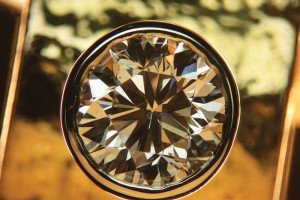A weighty issue

In general, there are four ways in which we are able to decide the weight of any stone: weigh it with a scale or balance, accept the word of a third party, estimate the weight, or calculate it using standardized volume formulae. On those rare occasions when we’re able to physically weigh a stone, it’s important to know the accuracy of the scale or balance we’re using and to that end, regularly scheduled calibration and maintenance are musts. If one lacks standardized, precision weights for calibrating a scale, it is good to get in the habit of using diamonds of known weight to verify that one’s scale is accurate.
This brings us to the next method: accepting the word of a third party. To use a stone of ‘known weight’ as a way of checking the accuracy of our own scales, we have to be willing to believe the scales at the gemmological laboratory issuing the grading report are accurate. Laboratory reports are becoming increasingly common, and while often a blessing for the appraiser, they present additional concerns. It’s too easy to simply accept the documents as ‘gospel’ and move on with the appraisal, at least if we have no bias in favour of or against the lab issuing the paperwork. Mistakes can happen, documents can be altered, and forgeries are becoming more of a concern. The concept of due diligence requires that to the best of our ability, we verify the information before we rely upon it. The Uniform Standards of Professional Appraisal Practice (USPAP) Ethics Rule and just good appraisal practice require we disclose our reliance on third-party documents. Such disclosure isn’t about dodging our professional responsibility or potential liability—we can’t. The point is to make users of the document aware of how we reached the value conclusion so they can decide how much credibility it warrants.
The final two methods of deciding a stone’s carat weight can be intertwined and the terms are sometimes mistakenly interchanged. Estimation and calculation aren’t the same, but there may be times when an estimate is required as part of a calculation. As an example, if one measures the diameter of a round brilliant to be approximately 4.1 mm, the stone’s ‘estimated weight’ could be stated as ‘one-quarter carat.’ On the other hand, if it is impossible to directly measure its depth, it may become necessary to resort to ‘sight estimation’ techniques to determine the total depth to complete a volume calculation. The weight is still a calculation, but it was partly derived from an estimate. However, I’m getting ahead of myself. In essence, an estimated weight presumes many unknown factors and may have a fairly wide margin of error. A calculated weight may also include certain presumptions, but it should have a much narrower margin of error. In either case, it’s good practice to include in the report what we believe the margin of error to be.





